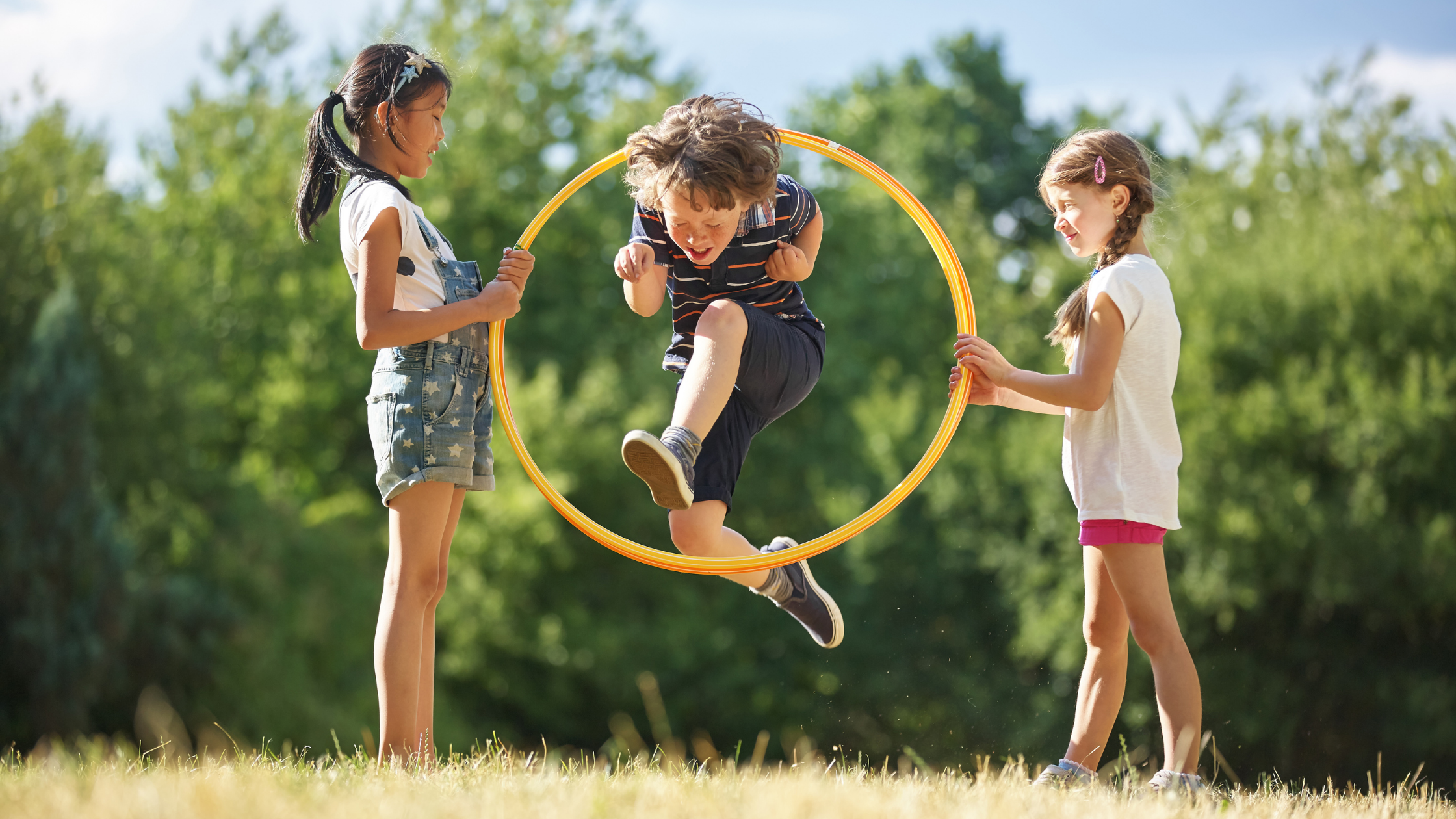
9 Activities for Students to Encourage Movement
Heading into the new school year, physical activity for children is a top priority to ensure kids build healthier minds and bodies that are ready to learn.
Explore our list of engaging and fun movement activities to incorporate within the school day and get kids excited about physical activity!
#1 Emoji Dance
Children love emojis! Sharpen their bodies and minds with this fun activity all about emojis. Let’s see the creative ways kids express themselves through movement and strengthen their social-emotional skills!
How to play:
Step 1: Ask children to draw several specific emojis on sheets of paper or cardboard. Each emoji should be large enough to cover the child’s face. Emojis might include a happy face, a face with heart-shaped eyes, a surprised face, a mad face, etc. If needed, explain that emojis represent emotions or feelings.
Step 2: Choose one emoji, and have children hold it up high.
Step 3: Play a few different types of music that might match the emoji. You may also ask kids to hum or sing a song they think represents the emoji.
Step 4: Match the emojis to music.
Step 5: Have each child hold their emoji up to their face and dance to represent the emoji. For example, for a happy face, kids can dance energetically and jump side-to-side. For a mad emoji, children can cross their arms and stomp.
Step 6: Discuss with the children why the movements and music represent each emoji.
Step 7: If desired, discuss ways children can recognize and talk about both their positive and negative emotions and feelings and ways they can calm down after big feelings like anger, excitement, and sadness.
#2 Zen Yoga
Grab a mat or towel, and get ready for some yoga! Pick a favorite spot inside, on the playground, or at a park.
Here are some yoga poses kids can try, but we encourage children to create their own poses.
Step 1: Start with both feet on the ground, standing tall.
Step 2: Bend one leg at the knee, and bring your foot off the ground slightly.
Step 3: Press the sole of your foot onto your calf or inner thigh.
Step 4: Raise your arms up like tree branches.
Step 1: Sit on the ground, and bring the soles of your feet together. Draw your heels toward your body, and relax your knees.
Step 2: Grab your toes and inhale. Be sure to sit up straight.
Step 3: Bend forward as you exhale, keeping your spine long.
Step 4: Take a breath as you gently sit up.
Step 5: Flap your butterfly wings (your legs).
#3 Hurdle and Go
What do blankets, chairs, boxes, string, and painter’s tape have in common? They are common household objects that can be used to create a fun obstacle course! Encourage kids to use their imaginations to find other items to design their obstacle course.
The course can be created with as few or as many obstacles as desired. Help children create a sequence of movements to complete their obstacle course. Some movements might correspond to features of your home such as twisting from side to side while standing under a door frame. Encourage children to think of several possible movements to complete each obstacle.
Let’s get started:
Set up two chairs back-to-back, three feet apart. Place a blanket over the chair backs to create a tunnel. Kids can crawl or walk on their knees under the blanket tunnel.
Step 1: Arrange boxes in a creative way such as a maze or a pattern and allow children to run, skip, jump, or walk within or around the boxes.
Step 2: Create a line or a zig zag with string or painter’s tape. Kids can hop, tiptoe, or walk along the line.
#4 Hop! Skip! Run! Relay
This activity is simple and fun for a group of children. Don’t underestimate the simplicity of a relay! This is an exciting activity to keep kids engaged in movement this fall.
Let’s get started:
Step 1: Designate a start and stop spot if needed.
Step 2: Group children into teams. Determine which team members will hop, skip, and run. Depending on the number of children participating, add or remove movements as desired. If desired, time your relay with a stopwatch or phone app.
Step 3: The first team member should hop or jump from one side of the room (or designated area) to the other.
Step 4: The next team member should skip.
Step 5: The last team member should run as fast back to the starting point.
Step 6: The team that finishes the relay first wins.
#5 What Animal Am I?
In this activity, children will act like their favorite animals! For example, if they love elephants, they can hang one arm out in front of their face and move their “trunk” from side to side. To become birds, they can flap their arms and jump or run around. Creativity is highly encouraged!
How to play:
Step 1: Ask one child to pretend to be their favorite animal.
Step 2: Ask the other children to guess what kind of animal a child is pretending to be.
Step 3: Take turns so everyone (including you!) has a chance to act like an animal.
#6 The Numbers Are Lost!
Encourage learning and movement with this simple number recognition activity. All you need to get started is paper and a pencil!
Let’s get started:
Step 1: Adults should write numbers on paper, and hide them around the home. Hiding spots might include under couch cushions, behind open doors, in the fridge, or taped on walls above a child’s eye level.
Step 2: Ask children to search for a particular number. When they find it (or another number), they should say the number’s name, and draw it in the air. Then, have children do that number of movements such as jumping jacks or lunges.
Step 3: Have children continue searching until all the numbers have been found.
#7 Tic-Tac-Go!
Engage children to move with a classic game of tic-tac-toe! All you need to get started is paper and a pencil.
How to play:
Step 1: Draw a tic-tac-toe board on the paper. If desired, you could use sidewalk chalk to draw a giant tic-tac-toe board outside on a sidewalk.
Step 2: Write a simple movement activity in each space. Movements might include touching toes, running in place, or a favorite dance move.
Step 3: Decide who will go first, and play tic-tac-toe. In this game, each player should complete the movement on their chosen space before they mark it with X or O. If desired, kids can also make a circle or an X with their arms to mark their space.
#8 Let’s Hopscotch
Get creative with a classic game of hopscotch! This activity can be completed indoors or outdoors.
Draw a hopscotch board outside on a sidewalk with sidewalk chalk, or create a board inside on the floor with painter’s tape. For this game, each child needs a sock that has been tied into a knot. If you have a yoga mat, you can also turn that into a hopscotch board with painter’s tape.
Let’s get started:
Step 1: Create the hopscotch board.
Step 2: Give each child a sock that has been tied into a knot.
Step 3: Children should take turns tossing the sock into a square. They should try to land the sock within the lines of the square.
Step 4: The child should hop along the board, skipping over the square where the sock landed, and continuing through to square 8. Tell children to hop on single squares with one foot, and land on double squares with one foot in each square.
Step 5: When the child reaches the last square, they should turn around and hop back in the opposite direction and finish where they started
#8 Gross Motor Bingo
Get kids moving with this fun twist on a traditional game! To play you will need paper, a pencil, and small objects that can be used as markers such as small toys, paper clips, spoons, pieces of paper, etc.
Let’s get started:
Step 1: Draw a 5 x 5 grid with 25 squares.
Step 2: Write “free” in the center space.
Step 3: Fill the 24 remaining spaces with different movements such as 10 bunny hops, a crab walk across the room, or a fun yoga position. Create a Bingo card for each child. All Bingo cards should include the same movements written in different spaces.
Step 4: Cut another sheet of paper into 24 pieces. Write each movement name on a piece of paper.
Step 5: Find objects to be used as markers.
How to play:
Step 1: Place the activity cards facedown in a pile. Give each child a Bingo card and items to use as markers.
Step 2: Turn over the first activity card, and call out the activity for children to complete. After they have completed the movement, children should cover the space on their Bingo card with a marker.
Step 3: Continue turning over cards and calling out activities until one child has covered five spaces in a vertical or horizontal line. At this point, the child should say, “Bingo.” If desired, continue the game until all children have covered five spaces in a row.
Sign up for a FREE 30-day trial of Walkabouts, the active learning platform for Pre-K to 2nd grade students. Web-based Walkabouts are easy to use from home or school.





